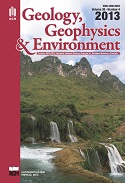2D Electrical Resistivity Tomography interpretation ambiguity - example of field studies supported with analogue and numerical modelling
DOI:
https://doi.org/10.7494/geol.2013.39.4.331Keywords:
Electrical Resistivity Tomography (ERT), ambiguity, 2D inversion, analogue and numerical modellingAbstract
Single Electrical Resistivity Tomography (ERT) survey was carried out in the Manor and Park Complex in Nowa Huta (Krakow Branice, Poland). It was applied at a small distance and parallel to the longer wall of a monumental building containing an empty 3 m deep basement. Analogue modelling was performed in order to recreate the field study at the proper scale. The laboratory set-up consisted of a water tank where electrodes were mounted to the particular plate, which rested on water surface. The basement model was made out of a non-conducting material. The default and robust inversions were tested and these variants were also considered with the use of numerical modelling. Laboratory experiments have confirmed that zones visible in the interpreted field section are caused by the influence of the building cellar located next to the survey line. Zones of this kind are additionally disturbed by the local geological structure. The experiment has pointed out, among others, that as the distance between the survey line and the underground body increases, the inversion results are still burdened by an object influence. Thus, similar situations can be verified with the use of analogue modelling presented in this paper or 3D numerical one.
Downloads
References
Amidu S.A. & Dunbar J.A., 2008. An evaluation of the electrical-resistivity method for water-reservoir salinity studies. Geophysics, 73, 4, G39-G49.
Cardarelli E., 2002. Geoelectric survey by ERT to investigate marble ruins at the Roman forum, Rome, Italy. European Journal of Environmental and Engineering Geophysics, 1, 219-228.
Cardarelli E. & Di Filippo G., 2009. Integrated geophysical methods for the characterisation of an archaeological site (Massenzio Basilica - Roman forum, Rome, Italy). Journal of Applied Geophysics, 68, 508-521.
Dahlin L.T., 1996. 2D resistivity surveying for environmental and engineering applications. First Break, 14,7,275-283.
Dahlin L.T., Forsberg K., Nilsson A. & Flyhammer P., 2006. Resistivity Imaging for Mapping of Groundwater Contamination at the Municipal Landfill La Chureca, Managua, Nicaragua. Near Surface 2006,12th European Meeting of Environmental and Engineering Geophysics, 4-6 September, Helsinki, Finland.
Daily W. & Ramirez A.L., 2000. Electrical imaging of engineered hydraulic barriers. Geophysics, 65, 1, 83-94.
Georgaki I., Soupios P., Sakkas N., Ververidisa K., Trantasa E., Vallianatos F. & Manios T., 2008. Evaluating the use of electrical resistivity imaging technique for improving CH4 and CO2 emission rate estimations in landfills. Science of the Total Environment, 389, 522-531.
Koefoed O., 1979. Geosounding Principles. Elsevier, Amsterdam.
Loke M.H., 2002. RES2DMOD ver. 3.01. Rapid 2D resistivity forward modelling using the finite-difference and finite-elements method. Geotomo Software. Manual.
Loke M.H., 2010a. RES2DINV ver. 3.59 for Window s XP/Vista/7, Rapid 2-D Resistivity & IP inversion using the least-squares method. Geotomo Software. Manual.
Loke M.H., 2010b. Tutorial: 2-D and 3-D electrical imaging surveys. Geotomo Software.
Loke M.H. & Barker R.D., 1996. Least squares deconvolution of apparent resistivity pseudo-sections. Geophysics, 60, 6, 1682-1690.
Loke M.H., Ackworth I. & Dahlin T., 2003. A comparison of smooth and blocky inversion methods in 2D electrical imaging surveys. Exploration Geophysics, 34, 182-187.
Metwaly M. & AlFouzan K., 2013. Application of 2-D geoelectrical resistivity tomography for subsurface cavity detection in the eastern part of Saudi Arabia. Geoscience Frontiers, 4, 4, 469-476.
Mościcki W.J., 2008. The application of resistivity investigations in archaeology - two case studies from Krakow, Poland. Near Surface 2008, 14th European Meeting of Environmental and Engineering Geophysics, 15-17 September 2008 Krakow, Poland. Extended Abstracts & Exhibitors'Catalogue, P58.
Schrott L. & Sass O., 2008. Application of field geophysics in geomorphology: Advances and limitations exemplified by case studies. Geomorphology, 93, 55-73.
Sechman H., Mościcki W.J. & Dzieniewicz M., 2013. Pollution of near-surface zone in the vicinity of gas wells. Geoderma, 197-198, 193-204.
Downloads
Published
Issue
Section
License
Authors have full copyright and property rights to their work. Their copyrights to store the work, duplicate it in printing (as well as in the form of a digital CD recording), to make it available in the digital form, on the Internet and putting into circulation multiplied copies of the work worldwide are unlimited.
The content of the journal is freely available according to the Creative Commons License Attribution 4.0 International (CC BY 4.0)










